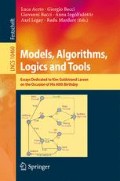Abstract
Milner’s CCS is a cornerstone of concurrency theory. This paper presents CCS as a cornerstone of concurrency practice. CCS is the semantic footing of pseuCo, an academic programming language designed to teach concurrent programming. The language features a heavily simplified Java-like look and feel. It supports shared-memory as well as message-passing concurrent programming primitives, the latter being inspired by the Go programming language. The behaviour of pseuCo programs is described by a formal translational semantics mapping on value-passing CCS and made executable using compilation to Java. pseuCo is not only a language but an interactive experience:  provides access to a web application designed for first hands-on experiences with CCS and with concurrent programming patterns, supported by a rich and growing toolset. It provides an environment for students to experiment with and understand the mechanics of the fundamental building blocks of concurrency theory and concurrent programming based on a complete model of the program behaviour. Altogether this implements the TACAS (Teaching Academic Concurrency to Amazing Students) vision.
provides access to a web application designed for first hands-on experiences with CCS and with concurrent programming patterns, supported by a rich and growing toolset. It provides an environment for students to experiment with and understand the mechanics of the fundamental building blocks of concurrency theory and concurrent programming based on a complete model of the program behaviour. Altogether this implements the TACAS (Teaching Academic Concurrency to Amazing Students) vision.
Access this chapter
Tax calculation will be finalised at checkout
Purchases are for personal use only
Notes
- 1.
- 2.
There are some corner cases requiring careful analysis. We omit them due to scope and space constraints.
- 3.
Reflexive and symmetric pairs are omitted directly for precision (by construction a memory access cannot race with itself) and efficiency reasons.
References
Andersen, J.R., Andersen, N., Enevoldsen, S., Hansen, M.M., Larsen, K.G., Olesen, S.R., Srba, J., Wortmann, J.K.: CAAL: concurrency workbench, aalborg edition. In: Leucker, M., Rueda, C., Valencia, F.D. (eds.) ICTAC 2015. LNCS, vol. 9399, pp. 573–582. Springer, Cham (2015). doi:10.1007/978-3-319-25150-9_33
Bolognesi, T., Brinksma, E.: Introduction to the ISO specification language LOTOS. Comput. Netw. 14, 25–59 (1987)
Boudol, G., Roy, V., de Simone, R., Vergamini, D.: Process calculi, from theory to practice: verification tools. In: Sifakis [25], pp. 1–10
CAV award (2013). http://i-cav.org/cav-award
Cleaveland, R., Madelaine, E., Sims, S.: A front-end generator for verification tools. In: Brinksma, E., Cleaveland, W.R., Larsen, K.G., Margaria, T., Steffen, B. (eds.) TACAS 1995. LNCS, vol. 1019, pp. 153–173. Springer, Heidelberg (1995). doi:10.1007/3-540-60630-0_8
Cleaveland, R., Parrow, J., Steffen, B.: The concurrency workbench. In: Sifakis [25], pp. 24–37
Cleaveland, R., Parrow, J., Steffen, B.: The concurrency workbench: a semantics-based tool for the verification of concurrent systems. ACM Trans. Program. Lang. Syst. 15(1), 36–72 (1993)
Cleaveland, R., Sims, S.: The NCSU concurrency workbench. In: Alur, R., Henzinger, T.A. (eds.) CAV 1996. LNCS, vol. 1102, pp. 394–397. Springer, Heidelberg (1996). doi:10.1007/3-540-61474-5_87
Dijkstra, E.W.: Over seinpalen. Circulated privately, n.d
Garavel, H.: Compilation et vérification de programmes LOTOS. Ph.D. thesis, Joseph Fourier University, Grenoble, France (1989)
The Go programming language specification. http://golang.org/ref/spec
Hansen, P.B.: Shared classes. In: Operating System Principles. Prentice-Hall Series in Automatic Computation, pp. 226–232. Prentice-Hall (1973)
Hansen, P.B.: Monitors and concurrent pascal: a personal history. In: Lee, J.A.N., Sammet, J.E. (eds.) History of Programming Languages Conference (HOPL-II), Preprints, Cambridge, Massachusetts, USA, 20–23 April 1993, pp. 1–35. ACM (1993)
Hoare, C.A.R.: Monitors: an operating system structuring concept. Commun. ACM 17(10), 549–557 (1974)
Holzmann, G.: The Spin Model Checker - Primer and Reference Manual, 1st edn. Addison-Wesley Professional, Boston (2003)
ISO. Information processing systems - Open Systems Interconnection - LOTOS - a formal description technique based on the temporal ordering of observational behaviour. ISO ISO 8807:1989, International Organization for Standardization, Geneva, Switzerland (1989)
Larsen, K.: Context-dependent bisimulation between processes. Ph.D. thesis, University of Edinburgh, Mayfield Road, Edinburgh, Scotland (1986)
Larsen, K.G., Pettersson, P., Yi, W.: UPPAAL in a nutshell. STTT 1(1–2), 134–152 (1997)
Aceto, L., Ingólfsdóttir, A., Larsen, K.G., Srba, J.: Reactive Systems: Modelling, Specification and Verification. Cambridge University Press, Cambridge (2007)
Magee, J., Kramer, J.: Concurrency - State Models and Java Programs. Wiley, Hoboken (1999)
Milner, R. (ed.): A Calculus of Communicating Systems. LNCS, vol. 92. Springer, Heidelberg (1980)
Milner, R.: Communication and Concurrency. PHI Series in Computer Science. Prentice Hall, Upper Saddle River (1989)
Milner, R.: Communicating and Mobile Systems - The Pi-calculus. Cambridge University Press, Cambridge (1999)
Roscoe, A.W.: Modelling and verifying key-exchange protocols using CSP and FDR. In: The Eighth IEEE Computer Security Foundations Workshop (CSFW 1995), 13–15 March 1995, Kenmare, County Kerry, Ireland, pp. 98–107. IEEE Computer Society (1995)
Sifakis, J. (ed.): CAV 1989. LNCS, vol. 407. Springer, Heidelberg (1990)
Soriano, A.: Prototype de venus: un outil d’aide á la verification de systemes communicantes. In: Cori, R., Wirsing, M. (eds.) STACS 1988. LNCS, vol. 294, pp. 401–402. Springer, Heidelberg (1988). doi:10.1007/BFb0035867
Acknowledgments
This work is supported by the ERC Advanced Investigators Grant 695614 (POWVER) and by the CDZ project CAP (GZ 1023).
Author information
Authors and Affiliations
Corresponding author
Editor information
Editors and Affiliations
Rights and permissions
Copyright information
© 2017 Springer International Publishing AG
About this chapter
Cite this chapter
Biewer, S., Freiberger, F., Held, P.L., Hermanns, H. (2017). Teaching Academic Concurrency to Amazing Students. In: Aceto, L., Bacci, G., Bacci, G., Ingólfsdóttir, A., Legay, A., Mardare, R. (eds) Models, Algorithms, Logics and Tools. Lecture Notes in Computer Science(), vol 10460. Springer, Cham. https://doi.org/10.1007/978-3-319-63121-9_9
Download citation
DOI: https://doi.org/10.1007/978-3-319-63121-9_9
Published:
Publisher Name: Springer, Cham
Print ISBN: 978-3-319-63120-2
Online ISBN: 978-3-319-63121-9
eBook Packages: Computer ScienceComputer Science (R0)

